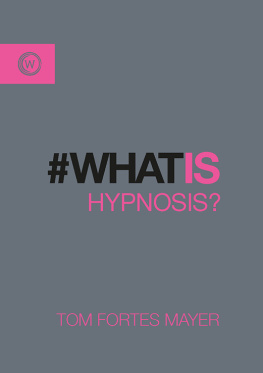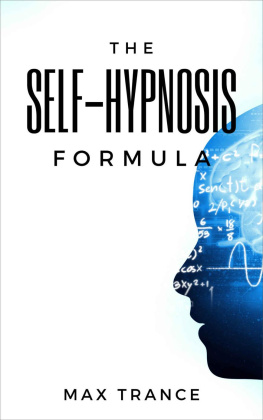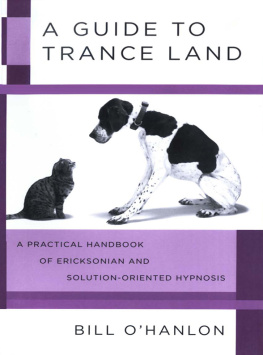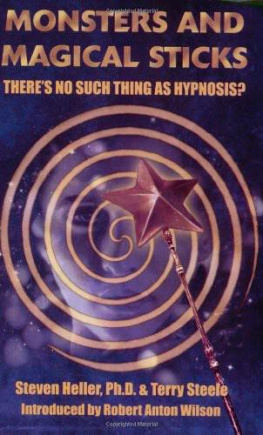THE INDUCTION OF HYPNOSIS

Copyright 2014
Jeffrey K. ZeigAll rights reserved under International and Pan-American Copyright Conventions. No part of this book may be reproduced, stored in a retrieval system or transmitted in any form by an electronic, mechanical, photocopying, recording means or otherwise, without prior written permission of the author.Library of Congress Cataloging-in-Publication DataThe induction of hypnosis: An ericksonian elicitation approach / Zeig, Jeffreyp. cm.Includes bibliographic references
ISBN 978-1-932248-67-8 (alk. paper)
1. HypnotismTherapeutic 2. Psychotherapy 3. Consciousness
I. II. TitleRC497.R67. 2014
616.89162dc19Published byT HE M ILTON H. E RICKSON F OUNDATION P RESS
2632 East Thomas Road, Suite 200
Phoenix, AZ 85016
Manufactured in the United States of America
To
MILTON H. ERICKSON , M.D.
for his dedication
Contents
From Induction to Evocative Grammar
Carl Whitaker introduced Jeffrey Zeig to me in December 1980, at the first International Congress on Ericksonian Approaches to Hypnosis and Psychotherapy held in Phoenix, Arizona. Shy as I was at the time, I did not understand the implications of this apparently casual encounter.
Like Milton Erickson, Carl Whitaker rarely made a single move that did not have multiple implications. For example, when I visited him in Wisconsin I experienced, at my personal expense, the indirect correction of my skeptical attitude toward the use of co-therapy when working with families. Carl took me canoeing with him on Lake Mendoza, and as I was having an incredibly pleasant experience, he confronted me, and helped me to consider co-therapy as an effective way of functioning. But what really convinced me to believe in co-therapy, was when on the next day he said, Today I have to work, so if you like, you can spend the morning enjoying the canoe all by yourself. As I tried to enjoy canoeing alone without Carl as a counterbalance, I immediately fell into the cold lake.
Today, I see the relationship of these two episodes as a way of suggesting collaboration, both in family therapy and in Ericksonian hypnosis. And since that first encounter with Jeff Zeig, I cannot see myself in the world of Ericksonian hypnosis without a continuous connection to hima relationship that was initiated by Carl 33 years ago.
My first impression of Jeff was one of curiosity. I thought to myself, How could this young man conceive and organize such an incredible event and be relaxed and smiling all the time? I never said this to Jeff, but I arrived at a definitive conclusion: He did it all while he was deeply hypnotized. Starting from that first Congress up to this new book, what continues to surprise me about Jeff is his way of teaching. The best comparison I can think of is Benvenuto Cellini, one of the greatest artists of the Italian Renaissance. Cellini was first and foremost a goldsmith, able to master small or large pieces that were always complex. I believe that Jeff is equal to Cellini in his ability to deconstruct a complex concept. In this book, he does just that presenting discrete and important details of induction. Like Cellini, after separating the parts, he reassembles them in a special way so that his teaching and therapy are infused with a vital spirit. The result is a richness and complexity of the construct that is never intimidating and always compelling. Discovering his multifaceted work as a collection of precious pieces, learners are eased onto the path of the therapeutic process and guided step by step. THE INDUCTION OF HYPNOSIS is one of those rare books that offer much more than what is implied in the title. Induction is only the center part of the medallion, because the entire field of hypnosis, including its history, myths, and definitions, also is explored. This book highlights both Zeigs philosophy and his evocative teaching style.
The tremendous amount of contained information could easily be lost if it did not have such intense impact. Continuously throughout the book creative, multilevel messages are interspersed, for example, in the chapter, Salvador Dali meets Milton Erickson, and in the idea of using moviemaking as a model for deconstructing and reconstructing the therapeutic process. A similar idea was proposed by the Tuscan painter Piero della Francesca. Due to his studies in geometry and mathematics, he applied to his art a new dimension of perspective, and the effect gave the image a more intense profundity and emotional impact. Jeff Zeig uses the same principles, but instead of enriching a painting with geometric dimensions, he adds to the induction process the evocative effect of art.
The great Venetian musician, Antonio Vivaldi, is another inspiration of indirect, multilevel communication; Baroque music was his art form. Vivaldi introduced the use of tonality to create a more ornate composition, and he also experimented with new instrumental playing techniques. Similar to Ericksonian indirect forms of communication, Baroque music expanded the field. It not only directly changed the notes, but it also intervened indirectly on the listener. The Baroque influence enlarged the scope and complexity of music, and enhanced the instrumental performance.
However, with Baroque-type embellishment theres always the risk that something might become too sophisticated and therefore distancing from everyday life experience. Yet in Jeff Zeigs approach to Ericksonian therapy, and in particular some of the complicated techniques, play a secondary role to the therapeutic goals. Complexity and ornamentation do not necessarily mean that something will be difficult to understand. Simplicity is not an antonym of complex but of complicated. For example, in the movies of Federico Fellini, Fellini was able to elicit intense emotions out of his characters simple everyday experience. But simplicity can be a creative act of fantasy, not necessarily a real description of personal experience. In the words of Fellini: It seems to me that I have invented almost everything: childhood, character, nostalgias, dreams, memories, for the pleasure of being able to recount them to people. Compare this with what Jeff Zeig says in Chapter 9: An induction can be created by talking about a topic that interests the patient, such as bike riding or walking. Even a commonplace task such as entering a room can be used as induction patter. The therapist merely uses the topic as a social context around which induction themes and principles are interspersed.
And if we accept, as Jeff Zeig maintains, that sculpting, painting, playing music, making movies, and doing psychotherapy are all able to elicit states, then we can say that both Fellini and Zeig dedicate their efforts to their artusing evocative grammar to elicit states.
Among the many demonstration sessions Ive seen Jeff doing, one remains most in my memory.
During a Congress in Rome, a woman asked for a smoking cessation intervention. During the therapy session, Jeff did not mention cigarettes once, or give instructions on how to quit a bad habit. Instead, he spoke of new and more satisfying experiences and of discovering real interests and neglected pleasures. At the end of the session, the woman declared that she was no longer interested in smoking. Yet a more unexpected surprise was the translators behavior. He was a professional translator, but after 15 minutes he began to make incredible mistakes. Everyone realized he was hypnotized except him. Suddenly in the session he said, Im tired. I would like to stop translating now. The audience understood this to mean that he wanted to interrupt the session. Only later did I learn that as a side effect of the indirect hypnosis received in the session, the translator decided to stop translating forever, and to completely change his life. Two years later, I tried to use his services for a new Congress, but he in fact confirmed that after Jeffs smoking cessation session he decided to quit his job and discover his real interests and neglected pleasures! He now lives in Sicily cultivating grapes and making excellent wine. When we last spoke, he also was newly married and his wife was pregnant. He considered all this a new and more satisfying experience. And if you are surprised to know that despite my many references to evocative Italian art and Italian artists that Jeffrey Zeig is not Italian, I can only comment with the ending words of a great Billy Wilders movie: Well, nobodys perfect.
Next page






